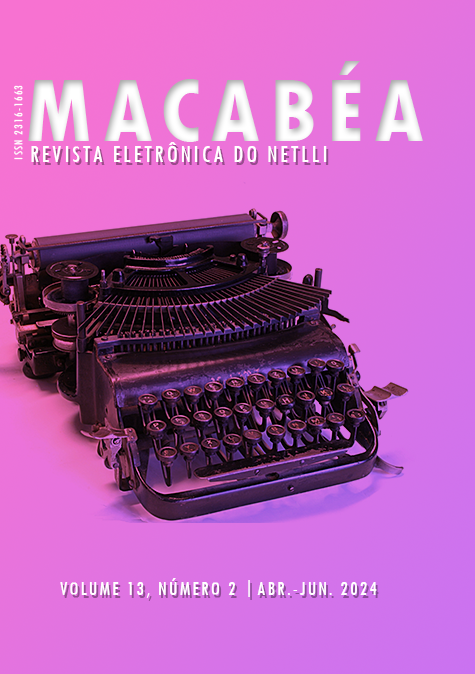SLASHER'S FILM NARRATIVES: A COMPARATIVE ANALYSIS OF METAFICTION STRATEGIES
UMA ANÁLISE COMPARATIVA SOBRE AS ESTRATÉGIAS DE METAFICÇÃO.
DOI:
https://doi.org/10.47295/mren.v13i2.1640Keywords:
Slasher. Metaficção. TerrorAbstract
In this paper we aim to show the relationship between the theory of Metafiction in film narratives of the horror genre known as Slasher. Under the view of Waugh (1984), we explore the history and functional aspects of metafictional theory, and use Hutcheon (1984) to understand how self-reflexivity manifests itself in these narratives. In terms of the specific aspects of the study of the genre in question, we use the work of Ponte (2011) and Cherry (2009) to show how these narratives can be connected to the influence of cinema on the culture and social organization of certain market niches. We analyzed, in total, clippings from 1 film and 2 episodes from series in the slasher subgenre: 1- “Condado Macabro” from 2015; the pilot episode of Tv show Slasher released in 2016 and the pilot episode of the series derived from the 2015 film Scream. With this in mind, we discuss the structural changes of the transition from the film genre to the television series, especially in the case of the Wes Craven series, originated from a previous film set. We discovered that all the objects analyzed presented, implicitly or explicitly, a correlation between Metafiction and intertextuality, especially through the questioning of making fiction and the description of its characters, as well as the association of symbols as a form of communication.
References
ANAFARTA, Orhan. Visual Literacy, Metafiction, and Horror Movies: an account of self-reflexivity In the new stalker film. Thesis (Doctor Of Philosophy In Art, Design And Architecture) . Institute Of Economics And Social Sciences And The Department Of Graphic Design Of Bilkent University. Ancara: Bilkent University, 2001. Disponível em: http://repository.bilkent.edu.tr/bitstream/handle/11693/29879/0001836.pdf?sequence=1&isAllowed=y. Acesso em: 27/09/2019.
BRANCO, Sinara de Oliveira. Linguística, tradução e estudos culturais. 2011.
CHERRY, B. Horror. Routledge Film Guidebooks. New York: Routledge. 2009.
CHESTERMAN, A. Memes of Translation: the spread of ideas in Translation Theory. Amsterdam: John Benjamins, 1997.
CHILDS, Peter; FOWLER, Roger. (editores). The Routledge dictionary of literary terms. London: Routledge, 1987.
FARIA, Zênia. A Metaficção Revisitada: uma introdução. Signótica, número 24, 237-251. Disponível em: https://www.revistas.ufg.br/sig/article/view/18739. Acesso em: 10/09/2019.
HUTCHEON, Linda. Narcissistic Narrative. The Metafictional Paradox. London: Methuen, 1984.
______. The Politics of Postmodernism: Parody and History. Cultural Critique, No. 5, Modernity and Modernism, Postmodernity and Postmodernism. (Winter, 1986-1987), pp. 179-207.
DUARTE, Rosália. Cinema & educação: refletindo sobre cinema e educação. In: KLAUS, Viviane. Revista Brasileira de Educação, Rio de Janeiro: n.23, maio/ago, 2002.
JAKOBSON, Roman. On Linguistics Aspects of Translation. In: VENUTI, L.The translation Studies Reader. London: Routledge, 2000.
PONTES, Charles Albuquerque. Indústria cultural, repetição e totalização na trilogia Pânico / Charles Albuquerque Pontes. -- Campinas, SP, 2011.
RODRÍGUEZ-ROMAGUERA, Guillermo. The Quixotic in Horror: Self-Generating Narrative and Its Self-Critical Sequel in Wes Craven's Self-Reflexive Cinema. Cervantes: Bulletin of the Cervantes Society of America, Volume 37, Number 2, Fall 2017, pp. 143-168. Disponível em: https://muse.jhu.edu/article/686456/summary. Acesso em: 25/09/2019.
WAUGH, Patricia. Metafiction: The Theory and Practice of Self-Conscious Fiction. London: Routledge, 1984
Downloads
Published
How to Cite
Issue
Section
License
Copyright (c) 2024 Shalatiel Bernardo Martins, Guilherme Mariano Martins da Silva

This work is licensed under a Creative Commons Attribution-NonCommercial-ShareAlike 4.0 International License.
Autores que publicam nesta revista concordam com os seguintes termos:
a. Autores mantém os direitos autorais e concedem à revista o direito de primeira publicação, com o trabalho simultaneamente licenciado sob a Licença Creative Commons Attribution que permite o compartilhamento do trabalho com reconhecimento da autoria e publicação inicial nesta revista.
b. Autores têm autorização para assumir contratos adicionais separadamente, para distribuição não-exclusiva da versão do trabalho publicada nesta revista (ex.: publicar em repositório institucional ou como capítulo de livro), com reconhecimento de autoria e publicação inicial nesta revista.
c. Autores têm permissão e são estimulados a publicar e distribuir seu trabalho online (ex.: em repositórios institucionais ou na sua página pessoal) a qualquer ponto antes ou durante o processo editorial, já que isso pode gerar alterações produtivas, bem como aumentar o impacto e a citação do trabalho publicado (Veja O Efeito do Acesso Livre).










